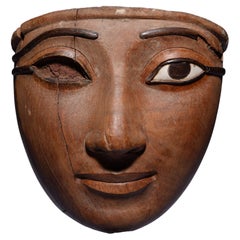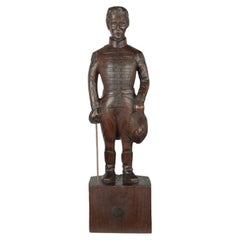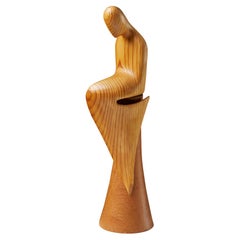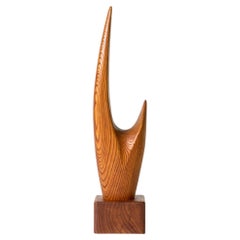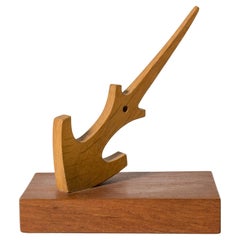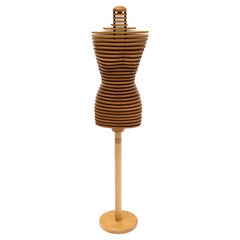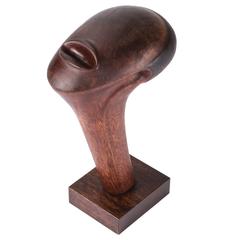Hardwood Figurative Sculptures
8
to
6
2
8
8
8
2
1
1
1
1
3
4
1
3
2
1
Height
to
Width
to
3,695
513
403
223
147
4
3
3
3
1
Material: Hardwood
Recognized Seller Listings
Exceptional Egyptian Sarcophagus Mask
Located in London, GB
Exceptionally Fine Wooden Sarcophagus Mask
Third Intermediate Period, 21st Dynasty, circa 1069-945 BC.
Acacia wood, rosewood, hippopotamus ivory
Masterfully carved from a single piece of fine-grained hardwood, the present mask is characteristic of the most exquisite funerary art made during the 21st Dynasty, and was probably commissioned for a particularly high-ranking individual.
The oval face displays a gently smiling mouth with full, outlined lips, furrows at the corners and a bow-shaped philtrum. The straight nose with rounded nostrils, the cheeks full and fleshy and the large, almond shaped eyes with heavy lids and tapering cosmetic lines, set below long, sweeping eyebrows.
Social collapse across the Mediterranean in the Late Bronze Age meant that the 21st Dynasty in Egypt was a period of great turmoil. Trade routes were disrupted, governments collapsed, and mass migration occurred. Economic scarcity meant that traditional funerary practices in Egypt were also affected, with a lack of material and financial resources leading to the reuse of preexisting material. As a result, during the 21st Dynasty, 19th and 20th Dynasty coffins changed ownership rapidly and were heavily recycled for new purposes. Tombs were also unmarked allowing them to be shared
by many people. These new practices brought forth a shift in the understanding of funerary paraphernalia. No longer important objects owned forever by the deceased, they were now simply seen as short-term transformative devices, whose symbolic and ritualistic meaning could be appropriated for others. However, paradoxically, the art of coffin-making also reached new heights during this period, and many of the richly dec- orated “yellow” coffins, characteristic of the 21st Dynasty, are remarkable works of art in their own right. Indeed, knowing that coffins were being reused throughout Egypt, the Egyptian élite set themself apart by commissioning lavish sarcophagi decorated with the images and texts meant to help guide them to the afterlife, and which would otherwise have adorned the tomb walls. As coffins were the chief funerary element which now identified the dead and allowed them a physical presence in the world of the living, their quality and appearance were of the utmost importance.
The traditional coffin ensemble was made of three parts: a wooden mummy cover, which laid directly atop the mummy, an inner coffin, and an outer coffin, both made of a lid and case. Additional decorative elements, such as masks, were carved out separately and later glued or pegged to the lids. After the completion of the painted decoration, the sarcophagus was covered in a varnish to give it its yellow colour. Gilding was sometimes used for the coffins of the high priests’ families, notably on parts representing naked skin, such as the face mask. However, some of the élite tactically avoided gilding altogether as to ensure that their coffin would not be looted.
When manufacturing the inner and outer coffins, particular attention was paid to the woodwork. Displaying the skill of the carpenter, this type of funerary art has largely remained unparalleled throughout Egyptian history. The principal wood used to craft the present mask is Acacia nilotica. The evergreen Egyptian acacia was considered sacred and said to be the tree of life, the birthplace of the god Horus, as well as symbolic of Osiris, the god of the dead and resurrection. The modelling of the face in the wood is superb, but the inlays also help mark this mask out as exceptional. Inlaid eyes and eyebrows were extremely rare and reserved to the finest and most expensive coffins. Traditionally, eyes were made of calcite, obsidian, or quartz, and eyebrows of coloured glass paste or bronze. Here, the pupils, eyebrows, and cosmetic lines are inlaid with Dalbergia melanoxylon, a rare type of wood which belongs to the rosewood genus.
In antiquity, however, it was known as Ebony of the Pharaohs, from the Egyptian word “hbny”, meaning dark timber, because of its black, lustrous appearance. An extremely dense and hard wood requiring significant skill to work with, ebony was a luxury material highly coveted by the pharaohs themselves, to make furniture, decorative and funerary objects. The wood was imported with great effort from the southern Land of Punt, most likely modern Sudan, Ethiopia, Djibouti, and Eritrea, alongside other luxury goods such as gold and ivory.
A magnificent ebony throne, recovered in the tomb of King Tutankhamun, illustrates the incredible aesthetic potential of this material and why it was so highly valued by Egyptian royalty. Only élite members of Egyptian society could have afford- ed Ebony of the Pharaoh inlays for their funerary mask.
The sclerae on the present piece were once both inlaid with hippopotamus ivory. Whiter than elephant ivory, this type of ivory is also denser, and more difficult to carve. The use of this luxury material, reputed for its gleaming appearance, enhances the lifelikeness of the eyes. For the Egyptians, hippopotamus ivory was imbued with magic powers. The hippopotamus was indeed both feared and venerated due to its aggressive behaviour. Whilst the male hippopotamus was associated with danger and chaos, the female was benevolent and invoked for protection, especially of the house and
of mothers and their children, through the hippopotamus goddess Tawaret. Thus, not only was hippopotamus ivory used as an inlay and to make practical objects, such as combs and clappers, but it was also used to make talismans like apotropaic wands or knives.
Made during a time of scarcity where few could afford made-to-order coffins, the present mask could have only belonged to one of the highest-ranking individuals in society. Undoubtedly one of the finest Egyptian coffin...
Category
15th Century and Earlier Egyptian Egyptian Antique Hardwood Figurative Sculptures
Materials
Fruitwood, Hardwood
An Anglo-Indian teak carving of Arthur Wellesley Circa 1803
Located in Lymington, Hampshire
This naïve likeness is carved from a solid teak block. The head has deep set eyes and a distinctive beaked nose. He is wearing a tailcoat with seven rows of frogging and tasselled ...
Category
Early 1800s Indian Antique Hardwood Figurative Sculptures
Materials
Teak
Sculpture “Mermaid” by Johnny Mattsson, Sweden, 1950’s
Located in Stockholm, SE
Sculpture “Mermaid” by Johnny Mattsson, Sweden, 1950s.
Pine with teak base.
Dimensions:
H: 28 cm/ 11"
D: 7 cm/ 2 3/4"
Johnny Mattsson was one of Sweden’s leading wood artists in t...
Category
1950s Swedish Mid-Century Modern Vintage Hardwood Figurative Sculptures
Materials
Teak, Pine
Midcentury Wooden Abstract Sculpture by Johnny Mattsson, Sweden, 1962
Located in Stockholm, SE
Striking wooden sculpture by Johnny Mattsson, in an abstract form. Pine on a teak base. The form of the sculpture follows the pine woodgrain in a beautiful way.
Category
1960s Swedish Scandinavian Modern Vintage Hardwood Figurative Sculptures
Materials
Teak, Pine
Large Holy Land Mother-of-pearl, Abalone Shell and Olive Wood Icon
Located in London, GB
A large Holy Land mother-of-pearl, abalone shell and olive wood icon
Jerusalem, early 20th century
Icon: height 55.5cm, width 52cm, depth 18cm
Case: height 15.5cm, width 61.5cm, depth 57.5cm
In fitted case, presented by the President of the Senate...
Category
Early 20th Century Israeli Modern Hardwood Figurative Sculptures
Materials
Mother-of-Pearl, Olive, Abalone
Midcentury wooden anchor sculpture by Johnny Mattsson, Sweden, 1950s
Located in Stockholm, SE
Lovely small anchor sculpture by Johnny Mattsson, sculpted from teak.
Aquatic themes are recurring in Johnny Mattsson’s artistry, sailing and the arc...
Category
1950s Swedish Scandinavian Modern Vintage Hardwood Figurative Sculptures
Materials
Teak
Pair of Italian Rococo Fruitwood Putti Figures
Located in New York, NY
Pair of hanging Italian Rococo (19th Cent) fruitwood carved putti figures wearing drape.
Category
19th Century Italian Rococo Antique Hardwood Figurative Sculptures
Materials
Fruitwood
Pair of Javanese Carved Teak Figures
Located in New York, NY
Pair of Asian Javanese (19/20th Cent) carved teak large figures with drape over shoulder and sword.
Category
19th Century Javanese Dutch Colonial Antique Hardwood Figurative Sculptures
Materials
Teak
Related Items
Antique Religious Bronze Wall Plaque of Holy Mary and Child after Donatello
Located in Lisse, NL
Symbolic and meaningful work of religious art.
Since the original by Donatello is in a museum somewhere, this beautiful bronze wall plaque 'after Donatello' is the best specimen you will be able to find anywhere. The original 'Mary and Child...
Category
Early 20th Century French Renaissance Revival Hardwood Figurative Sculptures
Materials
Bronze
Free Shipping
H 12.1 in W 8 in D 0.45 in
Large Decorative Bowl / Tray in the Manner of Johnny Mattsson
Located in Limhamn, Skåne län
Large decorative bowl / tray in the manner of Johnny Mattsson. Probably produced in Sweden.
Category
1950s Swedish Scandinavian Modern Vintage Hardwood Figurative Sculptures
Materials
Wood, Lacquer
Rare Aztec Colonial Polychromed Wood Sculpture! Holy Imagene Bultos Santos Icons
Located in Peoria, AZ
MUSEUM PERFECTION !
AZTEC INFLUENCED
LATIN AMERICAN
COLONIAL ART
AMAZINGLY RARE PIECE !
Approx. 14" x 8" x 2 1/2"
After Hernán Cortés conquered the Aztec empire, painting and sculpture schools were set up within missions to produce art for Roman Catholic worship in Spanish America to promote Christian evangelization. The works that emerge from this period are great historic treasures and tell us much about this time in history. Icons were important in this conversion process.
Here is an Imagene that was likely employed in a church from the 17th century. It features 5 elaborately carved faces and figures depicting angels and saints.
This piece is magnificent for many reasons, but the most important reason is that this piece illustrates the bridge between the Spanish and Aztec art schools.
The Aztecs had developed the most splendid feather art in the world. Feather mosaics (arte plumario in Spanish, amantecayotl in Nahuatl), were created by specially trained and talented Aztec nobles. The blue green iridescent color of hummingbird feathers had made them a regular form of tribute to Aztec rulers and art that featured these feathers were incomparable.
The Spanish art instructors adopted feathers into traditional Catholic imagery and this piece shows the result of such hybrid. Here feathers are
prominently sculpted into the background and were polychromed with sensational hues to reflect the native love and cultural appreciation for feather art. Few feather mosaics survive because of their temporal frailty, but the wood worked feathers in this piece give scholars and collectors a lasting indication of how Aztecs stylistically used the feathers in their pieces.
Aztec religious leaders wore headdresses and garments made of feathers - and here these saints appear to be wearing feather headdresses!
Even after centuries, the colors of this piece are incredibly compelling. Fragments of the rich blue green pigment that was applied to mimic the hummingbird feathers are still present. The golds, yellows and browns display spectacular understanding of complementary colors.
What's more this piece also shows Aztec sun imagery incorporated into the design! On the reverse side of the Saints' faces we see a vivid blue sun burst type design which clearly was an Aztec motif of the period and has no comparable counterpart in Catholic holy treasures...
Category
17th Century Mexican Spanish Colonial Antique Hardwood Figurative Sculptures
Materials
Wood
H 8 in W 14 in D 2.5 in
Ancient Egyptian Mask, 900-600 BCE
Located in Doylestown, PA
An ancient burial mask that was created to adorn a sarcophagus, 26th Dynasty, Minia, Mid-Upper Nile, circa 900-600BCE, from the collection of Joanna Barnes and Jack Warner, (Warner B...
Category
15th Century and Earlier Egyptian Egyptian Antique Hardwood Figurative Sculptures
Materials
Wood
Fine Pair French Abalone & Mother of Pearl Opera Glasses
Located in Bath, GB
A stunning pair of French Opera glasses made from gilded brass, all intact and original. The glasses are clad in alternating Mother of Pearl or Nacre shell...
Category
1920s French Art Deco Vintage Hardwood Figurative Sculptures
Materials
Brass
Antique French Parisian Mother-of-Pearl & Abalone Opera Glasses, Circa 1890.
Located in New Orleans, LA
Antique French Parisian Mother-of-Pearl & Abalone Opera Glasses with Original Case, Circa 1890.
Category
Late 19th Century French Antique Hardwood Figurative Sculptures
Materials
Abalone, Mother-of-Pearl
H 3 in W 4.25 in D 1.75 in
Grand Tour Ancient Egyptian Style Carved Soapstone Figure of Horus
Located in Stamford, CT
Grand Tour carving of Horus, ancient Egyptian god in the form of a falcon. Quite possibly much earlier in date, that is beyond my expertise. From a collection that did have ancient p...
Category
Late 19th Century Egyptian Egyptian Antique Hardwood Figurative Sculptures
Materials
Soapstone
Old Large Conch or Queen Helmet Shell, 1970
Located in Barcelona, Barcelona
Old large conch or Queen helmet shell, 1970
In original condition, with minor wear consistent with age and use, preserving a beautiful patina.
Mater...
Category
1970s Unknown Mid-Century Modern Vintage Hardwood Figurative Sculptures
Materials
Shell
Anglo Indian Elephant Ebony Wood Hand Carved Sculpture
Located in North Hollywood, CA
Ebony wood hand carved anglo Indian elephant sculpture.
Gorgeous vintage black hand carved wood ebony Anglo-Indian elephant.
This is a hand ca...
Category
Mid-20th Century Indian Anglo Raj Hardwood Figurative Sculptures
Materials
Wood
Anglo-Indian Etched and Painted Brass Peacock
Located in Stamford, CT
Beautifully rendered etched brass peacock, showing his feathers in full regalia. The surface highlighted with gold and orange paint. An exceptional decorative piece, bringing joy to ...
Category
Early 20th Century Indian Anglo-Indian Hardwood Figurative Sculptures
Materials
Brass
Large Statue of Saint Hand Carved in Wood
Located in Houston, TX
Large statue of saint hand carved in wood during the late 17th century, or early 18th century. Some restoration. Sculpture portrays a saint and originall...
Category
Late 17th Century Italian Baroque Antique Hardwood Figurative Sculptures
Materials
Wood
Large Vintage Anglo-Indian Paint Decorated Globe
Located in Palm Beach, FL
Unusual, vintage Anglo-Indian globe or orb crafted in ebonized wood and decorated in an elaborate well thought painted pattern. Presented on a classic brass clad stand.
Category
20th Century Indian Anglo-Indian Hardwood Figurative Sculptures
Materials
Paint
Previously Available Items
Vintage Italian Slatted Wooden Mannequin
Located in Austin, TX
Vintage Italian slatted wooden Mannequin made of cherrywood from from a fashion Milan atelier. Its made of cherrywood slats that stack together to form this sculptural form.
Category
1970s Italian Mid-Century Modern Vintage Hardwood Figurative Sculptures
Materials
Cherry
Mario Dal Fabbro Sculpture
Located in Chicago, IL
Mario Dal Fabbro Sculpture No. 5 "Agony"
Inscribed signature and date to underside
Mario Dal Fabbro 1969
Multi-disciplinary artist Mario Dal Fabbro was born in Cappella Maggiore...
Category
1960s American Mid-Century Modern Vintage Hardwood Figurative Sculptures
Materials
Teak
Recently Viewed
View AllMore Ways To Browse
Carved Stone Figure Head
Antique Italian Swords
Emperor Napoleon I
Fruit Sculpture Pair
Italian Renaissance Pedestals
French Mannequin Head
Ormolu And Bronze Statue
Bronze Zeus
Wood Statue Saint
Colorful Statue
Nude Bronze Relief
Life Sizes Carved Figures
Collection Porcelain Figurines
Antique Bronze Statue Woman
Antique Roof Tile
Antique Roof Tiles
Sandstone Head
The God Hermes
